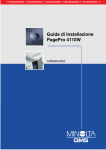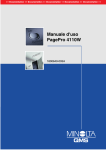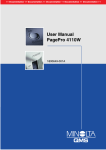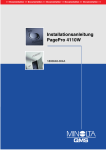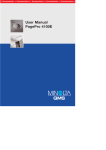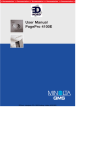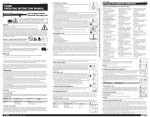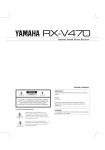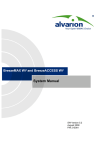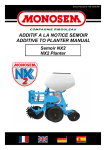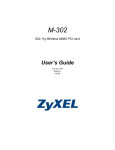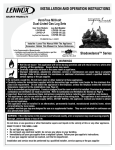Download MINOLTA-QMS PagePro 4110W Installation guide
Transcript
PP4110W_gb_pre.fm Page 2 Friday, December 1, 2000 7:28 AM Table of Contents 1 2 Introduction 1.1 Welcome to MINOLTA-QMS .........................................................1-1 1.2 Working safely with your laser printer........................................1-3 Notes on your safety and operating safety......................................1-3 Laser safety.....................................................................................1-5 Internal laser radiation.....................................................................1-5 CDRH regulations ...........................................................................1-6 Laser safety label ............................................................................1-6 Laser caution label ..........................................................................1-7 Ozone emission ..............................................................................1-7 1.3 CE symbol (Declaration of Conformity)......................................1-8 1.4 User instructions...........................................................................1-9 FCC Part 15 - Radio Frequency Devices Warning (for users in the USA)......................................................................1-9 Interference-causing Equipment Standard (ICES-003 ISSUE 3) Warning (for users in Canada) ......................................................1-10 Ozone emission ............................................................................1-10 Unpacking and setting up 2.1 Unpacking the laser printer..........................................................2-1 2.2 Overview of printer .......................................................................2-3 External printer parts.......................................................................2-3 Internal printer parts ........................................................................2-4 Optional printer parts.......................................................................2-5 Printer control panel ........................................................................2-6 2.3 Installing your laser printer .........................................................2-7 Place of installation .........................................................................2-7 Storage of consumables and accessories ......................................2-7 Ambient conditions..........................................................................2-8 Space required ................................................................................2-8 Space required for the standard model ..........................................2-8 Space required when equipped with options .................................2-9 2.4 Please note the following points:..............................................2-10 What should I watch out for when loading paper? ........................2-10 What should I watch out for when loading envelopes? .................2-10 Which sizes of paper can I use? ...................................................2-11 What types of paper can I use? ....................................................2-12 TOC-1 2.5 3 4 5 Installing the Printer driver 3.1 System requirements ................................................................... 3-1 3.2 Notes on installing the Printer driver ......................................... 3-1 General printer driver information ................................................... 3-2 Information on installation using Plug-and-Play or Add Printer Wizard ............................................................................................3-2 Information on installing a network printer...................................... 3-2 3.3 Installing the Printer Driver using the Installer.......................... 3-3 3.4 Uninstalling the Printer Driver..................................................... 3-5 Starting the Online Manual 4.1 Notes on the Online Manual ........................................................ 4-1 4.2 Start the Online Manual as follows:............................................ 4-2 Troubleshooting 5.1 6 Setting up your laser printer .................................................... 2-13 Fitting the paper output tray and paper feed tray 1 ..................... 2-13 Loading paper into paper feed tray 1 ........................................... 2-14 Connecting the power cable ........................................................ 2-15 Switching the printer on ................................................................ 2-16 Printing a configuration page ....................................................... 2-17 Connecting the printer to a computer (parallel port) .................... 2-18 Connecting the printer to a computer (USB port) ......................... 2-19 Installing the USB device driver for Windows 98 or Windows Me 2-19 Installing the USB Device Driver for Windows 2000..................... 2-22 Clearing a Paper Misfeed ............................................................. 5-1 Outside the Printer.......................................................................... 5-1 Inside the Printer ............................................................................5-2 Solving Print Quality Problems ....................................................... 5-2 No Output .......................................................................................5-2 Appendix 6.1 Performance features................................................................... 6-1 Hardware ........................................................................................6-1 Operating system ...........................................................................6-1 6.2 Technical specification ................................................................ 6-2 PagePro 4110W printer ..................................................................6-2 500-sheet paper feed tray (option) ................................................. 6-3 Duplex unit (option) ........................................................................6-4 Network card (option) ..................................................................... 6-4 TOC-2 Expansion memory module (option) ...............................................6-4 Interfaces and cables......................................................................6-5 USB interface and cable .................................................................6-5 6.3 Minolta-QMS's concern for environmental protection .............6-6 What does the energy star mean? ..................................................6-6 6.4 Index...............................................................................................6-7 TOC-3 TOC-4 1 Introduction 1 Introduction 1.1 Welcome to MINOLTA-QMS Thank you for purchasing a MINOLTA-QMS laser printer. This Installation Guide is a shortened version of the Online User’s Manual and will provide you all the important information you need to put your printer in operation. You will find information on the following topics: l Working safely with your laser printer l Unpacking and setting up l Installing the printer driver l Starting the Online User’s Manual l Technical data Read this introduction carefully before using your printer for the first time, and always keep the Installation Guide within reach. You will find the full version of the Online User’s Manual for your MINOLTA-QMS laser printer in digital format on the Software and Documentation CD-ROM that is supplied with your printer. The full manual contains extensive information on the following topics, among others: l Working with the printer driver l Working with the printer's Status Display l Installing optional accessories l Caring for and maintaining your printer l Identifying and resolving problems MINOLTA-QMS reserves the right to make changes to the contents of this manual without notice. 1-1 1 Introduction Trademarks Centronics is a registered trademark of Centronics, Inc. Microsoft, Windows and Windows NT are registered trademarks of Microsoft Corporation. IBM is a registered trademark of the International Business Machines Corporation. Adobe, PostScript and the PostScript logo are trademarks of Adobe Systems, Inc. PagePro is a trademark of Minolta Co., Ltd. Fine-ART and Fine Micro Toning are trademarks of Minolta Co., Ltd. MINOLTA-QMS and the MINOLTA-QMS logo are registered trademarks of MINOLTA-QMS, Inc. All other names of products and brand-names are trademarks or registered trademarks of their respective proprietors. 1-2 1 Introduction 1.2 Working safely with your laser printer Notes on your safety and operating safety Working improperly with the printer can result in health hazards and electric shocks, and may even cause fires. Before you unpack the laser printer, you should make yourself familiar with this information regarding your safety and operating safety. CAUTION Observe the following information: Ü Make sure that the power cable is correctly plugged into the socket and that the socket is at all times visible and readily accessible. Ü Do not pull the cable of the power plug as this may damage the cable. The result could be an electric shock or a fire. Ü Remove the power plug from the socket if the machine will not be used for an extended period of time. Ü Do not remove the power cable from the socket with wet hands as this may result in an electric shock. Ü Do not move the unit unless the power cable has been removed from the socket. Otherwise, you may damage the cable. The result could be a short-circuit or a fire. Ü Do not place any heavy objects on the power cable. Do not pull or kink the cable as this can result in damage to the cable. The result could be an electric shock or a fire. Ü Make sure that the machine is not standing on a cable connected to another machine as this can result in damage to that cable. The result could be a fire or improper functioning of the unit in question. Ü Make sure that the power supply to the unit has the correct voltage. Otherwise, the result could be a fire or an electric shock. Ü Switch off the unit immediately and unplug the power cable if the power supply cable is damaged. Failure to do so could result in a fire or an electric shock. Contact your customer support technical specialist. Ü Use only extension cables that are designed for at least the maximum power rating of the machine. Extension cables with lower ratings can result in overheating and can even cause a fire. 1-3 1 1-4 Introduction Ü Perform only the procedures that are described in this manual. Using the machine improperly can result in a fire or an electric shock. Ü Do not place any heavy objects on the machine. Ü Do not open any covers on the machine while printing is in progress. Ü Do not switch off the unit while printing is in progress. Ü Do not place any magnetic object near the machine. Ü Do not use any flammable sprays, liquids, or gases in the vicinity of the machine. Ü Do not remove any safety devices and do not alter the construction of the machine. The unit is equipped with high-voltage components. Using the machine improperly can result in a fire or an electric shock. Ü Do not insert any paper clips, staples or other small metal objects into openings on the machine. The result could be an electric shock or a fire. If metal pieces are fed into the machine, switch it off immediately, disconnect the power cable and contact your customer support technical specialist. Ü Do not place coffee cups, drink bottles, or other containers with liquids in them on the machine. If liquid enters the machine, the result could be an electric shock or a fire. If liquid does get into the machine, switch it off immediately, disconnect the power cable and contact your customer support technical specialist. Ü If the machine becomes unusually hot, or if you notice smoke or an unusual odor coming from the machine, switch it off immediately and remove the power cable from the socket. Contact your customer support technical specialist. 1 Introduction Laser safety This printer is equipped with a laser unit. If the printer is used in accordance with the instructions in the Online User’s Manual, the laser presents no danger. The radiation emitted is completely absorbed and attenuated by the case. The laser radiation cannot escape at any time during the printing process. This printer is certified as a Class I Laser product under the US Department of Health and Human Services (DHHS) Radiation Performance Standard according to the Radiation Control for Health and Safety Act of 1968. This means that the printer does not produce hazardous laser radiation. Internal laser radiation Average radiation output: 1.03 mW at the laser aperture of the print head unit. Wavelength: 770-810 n This device works with a laser diode of class 3b with invisible laser radiation. The laser diode and the polygon mirror for sampling are integrated into the laser unit. The laser unit is NOT AN ITEM TO BE MAINTAINED ON SITE. You should therefore not open it under any circumstance. CAUTION Dangerous laser radiation! Using the printer in a manner other than indicated in this manual may result in exposure to dangerous radiation. Ü Use the printer only according to the instructions contained in this guide and in the Online User’s Manual. 1-5 1 Introduction CDRH regulations On 2 August 1976 the Center for Devices and Radiological Health (CDRH), part of the US Food and Drug Administration, introduced specifications for all products that operate with laser beams. Products which are to be sold or used in the USA must comply with these statutory requirements without exception. The safety label shown confirms compliance with the CDRH regulations. This label must be attached to all products sold or used in the USA. Laser safety label DANGER Use the printer only as described in this manual! Using the controls, adjusting the printer or performing procedures other than specified in this manual may result in exposure to hazardous radiation. Ü 1-6 Use the printer only according to the instructions contained in this guide and in the Online User’s Manual. 1 Introduction Laser caution label CAUTION Dangerous laser radiation! This is a semiconductor laser. The maximum power of the laser diode is 5 mW and the wavelength is 770–810 nm. Ü Use the printer only according to the instructions contained in this Guide and in the Online User’s Manual. Ozone emission Small quantities of ozone escape during the printing process. These quantities do not represent a health hazard. In spite of this, you should take care that the area in which the machine is located has adequate ventilation, especially when you are printing large quantities of materials or when the machine is being used continuously over a long period of time. 1-7 1 1.3 Introduction CE symbol (Declaration of Conformity) We hereby declare that we are responsible for ensuring that the printer and the options to which this declaration relates comply with the specifications given below. This declaration shall only apply to the area of the European Union (EU). Product Type Laser Beam Printer Product Name PagePro 4110W Options • • • • • Standard EC Directive Paper feed tray 2 Paper feed tray 3 Duplex unit Expansion memory (Maximum 64MB) Network interface card Safety*2 • EN60950/1992 with Amendments 1, 2, 3, 4 and 11 Safety of information technology equipment, including electrical business equipment • EN60825-1/1994 with Amendment 11 Radiation safety of laser products, equipment classification, requirements and User’s guide EMC*1 • EN55022 (Class B)/1998 Limits and method for measurement of radio disturbance characteristic of information technology equipment (ITE) • EN55024/1998 Information technology equipment – immunity characteristics – Limits and methods of measurement • EN61000-3-2/1995 Limits for harmonic current emissions • EN61000-3-3/1995 EMC, Part 3: Limits Section 3: Limitation of voltage fluctuations and flicker in low voltage supply systems for equipment with rated current ≤ 16A. • IEC 61000-4-2/1995 Electrostatic discharge immunity test • IEC 61000-4-3/1995 Radiated, electromagnetic field immunity test • IEC 61000-4-4/1995 Electrical fast transient/burst immunity test • IEC 61000-4-5/1995 Surge immunity test • IEC 61000-4-6/1996 Immunity to conducted disturbance, inducted by radio-frequency fields • IEC 61000-4-8/1993 Power-frequency magnetic field immunity test • IEC 61000-4-11 Voltage dips, short interruptions and voltage variations immunity test Safety 73/23/EEC EMC 89/336/EEC and 93/68/EEC * 1: EMC performance: This product was designed for operation in a typical office environment 2: First year of labelling according to EC-directive 73/23/EEC and 93/68/EEC: 2000 This unit must be operated with a shielded interface cable and a shielded network cable. The use of non-shielded cable can result in radio interference and is forbidden according to EC Regulation 89/336/EEC. 1-8 1 Introduction 1.4 User instructions FCC Part 15 - Radio Frequency Devices Warning (for users in the USA) FCC: Declaration of Conformity Product type Laser Beam Printer Product name PagePro 4110W Options Paper feed tray 2 Paper feed tray 3 Duplex unit Expansion memory (Maximum 64MB) Network interface card This device complies with Part 15 of the FCC Rules. Operation is subject to the following conditions: 1. this device may not cause harmful interference, and 2. this device must accept any interference received, including interference that may cause undesired operation. This equipment has been tested and found to comply with the limits for a Class B digital device, pursuant to Part 15 of the FCC Rules. These limits are designed to provide reasonable protection against harmful interference in a residential installation. This equipment generates, uses and can radiate radio frequency energy and, if not installed and used in accordance with the instructions, may cause harmful interference to radio communications. However, there is no guarantee that interference will not occur in a particular installation. If this equipment does cause harmful interference to radio or television reception, which can be determined by turning the equipment off and on, the user is encouraged to try to correct the interference by one or more of the following measures: l Reorient or relocate the receiving antenna. l Increase the separation between the equipment and the receiver. l Connect the equipment into an outlet on a circuit different from that to which the receiver is connected. l Consult the dealer or an experienced radio/TV technician for help. 1-9 1 Introduction This device must be used with a shielded interface cable and shielded network (10BaseT/100baseTX)cable. The use of non-shielded cables is likely to result in interference with radio communications and is prohibited under FCC rules. The design and production of this unit conform to FCC regulations, and any changes or modifications must be registered with the FCC and are subject to FCC control. Any changes made by the purchaser or user without first contacting the manufacturer will be subject to penalty under FCC regulations. Interference-causing Equipment Standard (ICES-003 ISSUE 3) Warning (for users in Canada) This Class B digital apparatus complies with Canadian standard ICES-003. Cet appareil numérique de la classe B est conforme à la norme NMB-003 du Canada. Ozone emission Small quantities of ozone escape during the printing process. These quantities do not represent a health hazard. In spite of this, you should take care that the area in which the machine is located has adequate ventilation, especially when you are printing large quantities of materials or whether the machine is being used continuously over a long period of time. 1-10 Unpacking and setting up 2 Unpacking and setting up 2.1 Unpacking the laser printer 2 CAUTION Danger to children from packaging materials made of plastic Ü After unpacking the printer, keep the packaging materials out of reach of children. 1 Remove the printer parts and accessories from the box. m m m m m m Paper output tray Printer Installation Guide Software and Documentation CD-RO Power cable Paper feed tray Interface cables are not included in the shipment. If you need interface cables, contact your local vendor or computer store 2 Remove the packaging material from the printer. 3 Remove the transport retainers from the printer. 2-1 2 Unpacking and setting up 4 Pull the plastic strip out of the printer. 5 Remove the plastic strip from the rear of the printer. . Why save the packaging materials? If you need to move the printer, you can use the packaging again. In this way you can be certain that your printer is correctly packed. 2-2 2 Unpacking and setting up 2.2 Overview of printer External printer parts 1 2 3 4 5 8 7 6 9 10 12 11 No. Description No. Description 1 Release button for top cover 7 Power Switch (ON/OFF) 2 Control panel 8 Cover for paper feed tray 1 3 Paper output tray (face down) 9 USB port 4 Top Cover 10 Socket for power cable 5 Paper guides 11 Parallel port 6 Paper feed tray 1 (multipurpose tray) 12 NIC option port 2-3 2 Unpacking and setting up Internal printer parts 1 5 2 3 4 6 2-4 No. Description No. 1 Fusing unit 4 Description Cover for paper feed tray 1 2 Paper guide 5 Image transfer roller 3 Manual paper feed unit 6 Imaging cartridge 2 Unpacking and setting up Optional printer parts 1 2 3 4 No. No. Description 1 Description Paper feed tray 2 (500-sheet cassette) 3 Duplex Unit 2 Paper feed tray 3 (500-sheet cassette) 4 Network interface card 2-5 2 Unpacking and setting up Printer control panel 1 2 3 4 5 The control panel has four indicators and one button. No. Description No. Description 1 Fault (orange) 4 Ready (green) 2 Toner empty (orange) 5 Control button 3 Paper empty (orange) Please refer to the Online User’s Manual for detailed information on the control panel. 2-6 Unpacking and setting up 2.3 2 Installing your laser printer Place of installation The printer should be set up in a place which is l dry and free from dust l on a stable surface l well ventilated l away from highly flammable items (for example, curtains) l away from objects which might obstruct the printer’s ventilation slits l near to an easily accessible power socket The printer must be positioned in a way that it cannot be adversely affected by the following: l splashing liquids l organic gases (for example, ammonia) l direct sunlight l severe temperature fluctuations l exhaust-air from heating, ventilation or air-conditioning systems Storage of consumables and accessories Printing consumables and accessories should be kept: l sealed in their original packagings, l protected against direct sunlight or heat, l protected against fluorescent light, l in a cool, dry and dust-free place, l out of the reach of children. CAUTION Toner poses a health hazard! Toner may be harmful if inhaled. Ü If you inhale toner, consult a doctor immediately. Ü If you get toner on your hands, wash them immediately with cold water and soap. 2-7 2 Unpacking and setting up Ambient conditions The optimum ambient conditions for your printer are: l Temperatures from 50°F to 95°F / 10°C to 35°C (maximum variation of 18°F / 10°C per hour) l Relative humidity of 15% to 85% (maximum variation of 20% per hour) Space required Make certain that there is enough space available around the printer (see illustration). This will facilitate operation, reloading paper and toner, and maintenance of the printer. Space required for the standard model printer H D C G A E F No. 2-8 Dimension No. B Dimension A 40-1/2 in. / 1030 mm E 23-1/2 in. / 600 mm B 33 in. / 840 mm F 11-3/4 in. / 300 mm C 24-3/4 in. / 630 mm G 4 in. / 100 mm D 6 in. / 150 mm H 11-3/4 in. / 300 mm 2 Unpacking and setting up Space required for the printer when equipped with options H C D G A E F B No. Dimension No. Dimension A 40-1/ 2in . /1 030mm 46-1/2 in. *1 / 1180 mm *1 E 23-1/2 in. / 60 0mm B 33 in. / 840 mm F 11-3/4 in. / 30 0mm C 29-1/ 2in . /7 50mm 34-1/4 in *2 / 870 mm * 2 G 4 in. / 10 0mm D 6 in. / 150 mm 11-3/4 in *1 / 300 mm *1 H 11-3/4 in. / 30 0mm * 1: when equipped with a duplex unit 2: when equipped with a third paper cassette unit 2-9 2 2.4 Unpacking and setting up Please note the following points: What should I watch out for when loading paper? To avoid paper misfeeds in the laser printer, please observe the following points: l Do not use any paper with the following features: m m m m m m m m m m l Paper that has already been used in a thermal or ink-jet printer. Paper that is too thin or too thick. Folded or wavy paper. Paper having binding holes or perforations. Paper with a surface that is too smooth, too rough or irregular. Specially coated paper such as carbon paper or paper with an adhesive surface. Paper that is not cut at right angles. Paper that is held together by glue, adhesive or clips. Paper with labels that detach easily. Warped or curled-up postcards. Please note that the stack of paper in the paper tray should not exceed the “max.” mark. . Note When paper is loaded, the orientation is based on the format marks in the paper source units. What should I watch out for when loading envelopes? To avoid envelope misfeeds in the laser printer, please observe the following points: 2-10 l Do not use self-adhesive envelopes or those with a tear-off strip, closures or a window. l Place the envelopes in the tray long edge first. l Place the envelopes in the tray with the flap down so that the upper surface of the envelopes is lying against the side of the tray with the feed roller. l Load envelopes of format B5 with the flap facing down and pointing to the rear of the tray. l Make certain that the flaps are neatly folded back. 2 Unpacking and setting up . Test the envelopes before buying large quantities! Some types of envelopes crease easily when they are run through a printer. Test a type of envelope before purchasing large quantities. Which sizes of paper can I use? This printer is designed for use with the sizes of paper listed below. Paper source Tray 1 Tray 2/3 (option) Manual paper feed unit A4 210 × 2 97mm Yes Yes Yes A5 148 × 2 10mm Yes No Yes JIS B5 18 2 × 257mm Yes Yes Yes Letter 8-1/2 in. × 11 in. Yes Yes Yes Legal 8-1/2 in. x 14 in. Yes Yes Yes Executive 7-1/2 in x 10-1/2 in. Yes Yes Yes Paper size Standard sizes Envelopes, postcard and custom sizes Envelope DL 110 × 220mm Yes No Yes Envelope C5 162 × 250mm Yes No Yes Envelope B5 176 × 250mm Yes No Yes Envelope COM10 4-1/8 in. x 9-1/2 in. Yes No Yes Envelope Monarch 3-7/8 in. x 7-1/2 in. Yes No Yes J-Post (Postcard) 4 in. x 5-3/4 in. Yes No Yes Custom Size 3-3/8 in. to 8-1/2 in. × 3-1/2 in to 14 in. 86 to 21 6mm × 9 0 t o356mm Yes No Yes 2-11 2 Unpacking and setting up What types of paper can I use? This printer is designed for use with the types of paper listed below. Paper source Tray 1 Tray 2/3 (option) Manual paper feed unit Plain paper weight: 16 to 24 lbs. / 60 to 90g/m2 Yes Yes Yes Recycled paper weight: 16 to 24 lbs. / 60 to 90g/m2 Yes Yes Yes Yes No Yes Paper media standard media: special media: Transparent film Labels Yes No Yes Letterhead Yes No Yes Envelopes Yes No Yes Postcards Yes No Yes Card or thick paper 24 to 43-1/4 lbs. / 9 0 to 163g/m2 Yes No Yes . Note Special media is not supported for duplex printing. 2-12 Unpacking and setting up 2.5 2 Setting up your laser printer Fitting the paper output tray and paper feed tray 1 1 Attach the paper output tray to the printer as shown. 2 Slide the lower part of the paper feed tray into the printer. 3 Place the cover on top of paper feed tray 1. 2-13 2 Unpacking and setting up Loading paper into paper feed tray 1 Paper feed tray 1 has a capacity of 250 sheets of plain papier. 1 Remove the cover of paper feed tray 1. ? Using a large paper format? Ü 2 Then extend the paper support. Place the paper between the paper guides. Slide the guides up to the stack of paper. many sheets may I place ? How in the cassette? Ü 3 2-14 The stack of paper should not exceed the “ma x.”mark. Place the cover on top of paper feed tray 1. Unpacking and setting up 2 Connecting the power cable Only use the power cable supplied with the printer. The laser printer requires a power supply with minimal voltage and frequency fluctuation. If necessary, ask an electrician for advice. 4 Power supply: 120-127 V at 50-60 Hz / 220-240 V at 50-60 Hz 4 Voltage fluctuation: 120V -10%, 127 V +6% / 220-240 V ±10% 4 Frequency fluctuation: Within 3 Hz 1 Make certain that the printer's power switch is in the “0” (OFF) position. 2 Insert the plug on the end of the power cable (supplied) into the power socket of the printer. 3 Insert the other end of the power cable into a power socket. CAUTION Using the wrong power cable may cause a short-circuit! Using power cables of inadequate cross-section can lead to overheating of the cable. Ü Only use an extension cable which has a higher rating than the current consumption of the printer. Ü Only use cables with a ground connection. Ü Always observe the relevant local regulations regarding the connection of electrical equipment to the main power. 2-15 2 Unpacking and setting up Switching the printer on CAUTION Improper handling may result in damage to the printer! Ü Never switch off the printer while a print job is in progress, the printer is receiving data from the computer (flashing “Ready” indicator on the control panel) or the printer is being reset. 1 Switch the power switch to “I”(ON). The printer is ready for use after approximately 23 seconds. . Saving energy makes sense! After the printer has not received a print command for approximately 15 minutes, it automatically switches to POWER SAVE mode. If the printer receives a new print job while it is in Power Save mode, or if the top cover is opened, or if the control button is pressed, the printer automatically starts its warm-up phase. 2-16 Unpacking and setting up 2 Printing a configuration page Print a configuration page in order to make sure that the printer is functioning properly. 1 Make sure that correct media is placed in paper feed tray 1. 2 Hold down the [CONTROL BUTTON] for more than 15 seconds until the “Toner empty” and “Ready” indicators flash as shown below. After the control button is released, the Configuration Page is printed. . Be well prepared for technical queries. Please have a current configuration page available when calling for technical assistance. Make a note of the Serial No. of your printer on the configuration page, see page 1-6 (laser safety label). 2-17 2 Unpacking and setting up Connecting the printer to a computer (parallel port) 1 Switch off the printer and the computer. 2 Connect one end of the interface cable to the parallel port of your computer. 3 Connect the other end of the interface cable to the parallel port of the printer. 4 Secure the connector by means of the clips on the socket. For the technical specifications of the cable, see page 6-5. CAUTION Using the wrong type of cable may result in damage to the equipment! Using the wrong type of cable may damage the socket on the printer. 2-18 Ü Only use an IEEE 1284 type B shielded interface cable for connecting the printer to your computer. Ü MINOLTA-QMS does not warrant the use of any particular cable. The user assumes all responsibility as to the quality and performance of the cable. 5 Proceed with chapter 3, “Installing the Printer driver.” 2 Unpacking and setting up Connecting the printer to a computer (USB port) When connecting the PagePro 4110W printer to your computer with a USB cable, you must first install the PagePro 4110W USB device driver before you install the printer driver. . Note In the following procedures it is assumed that you are installing the PagePro 4110W USB device driver on your computer for the first time. This printer can be connected with a USB cable only if your computer is running Windows 98, Windows Me, or Windows 2000. Installing the USB device driver for Windows 98 or Windows Me . Note The screen images shown in this section are examples of the installation for Windows 98. The screen images may differ slightly for Windows Me. 1 Switch on your computer and start Windows 98 or Windows Me. 2 Switch on the printer. Do not yet connect the USB cable. 3 Check that Windows 98 or Windows Me has finished loading and that the printer is ready. 4 Insert the Software and Documentation CD-ROM supplied with your printer into your computer’s CD-ROM drive. 5 When the CD-ROM installation screen appears, close it. 6 Connect the printer to the computer with the USB cable. 2-19 2 Unpacking and setting up 7 The Add New Hardware Wizard dialogue will display. 8 Install the USB device driver from the Software and Documentation CD-ROM by following the instructions on the screen. During the installation specify the location of the USB Driver on the Software and Documentation CD-ROM as follows: m m For Windows 98: “Drivers\Pp4110W\Win98\Gb\Gdi\Drv\usb” For Windows Me: “Drivers\Pp4110W\Win Me\Gb\Gdi\Drv\usb” ? Need more information? Ü 2-20 For detailed information on the installation settings please refer to the Online User’s Manual. Unpacking and setting up 9 2 After the USB device driver is installed, a “greetings” screen appears. Although you may proceed with this screen now to install the printer driver, we recommend that you exit this screen and install the printer driver later using the CD-ROM installer. 10Check that “Minolta/QMS PagePro 4110W” appears below Universal serial bus controller on the Device Manager tab of the System Properties dialogue. ? How do I open the System Properties Dialogue? Ü Click with the right-hand mouse button on the [MY COMPUTER] icon on the desktop, and then click [PROPERTIES] in the shortcut menu that appears. 11Proceed with chapter 3, “Installing the Printer Driver.” 2-21 2 Unpacking and setting up Installing the USB Device Driver for Windows 2000 2-22 1 Switch on your computer and start Windows 2000. 2 Switch on the printer. Do not yet connect the USB cable. 3 Check that Windows 2000 has finished loading and that the printer is ready. 4 Insert the Software and Documentation CD-ROM supplied with your printer into your computer’s CD-ROM drive. 5 When the CD-ROM installation screen appears, close it. 6 Connect the printer to the computer with the USB cable. 7 The Found New Hardware Wizard dialogue will display. 2 Unpacking and setting up 8 Install the USB device by following the instructions on the screen. During the installation specify the location of the USB Driver on the Software and Documentation CD-ROM as follows: “Drivers\Pp4110W\Win2000\ Gb\Gdi\Drv\usb.” ? Need more information? Ü 9 For detailed information on the installation settings please refer to the Online User’s Manual. When the following dialogue appears, check the “Disable the device. The Add/Remove Hardware Wizard in the Control Panel can be used complete the driver installation.” box, and then click [FINISH]. 10Open the “Device Manager.” Then double-click the “USB Printing Support” below “Universal Serial Bus controllers.” 2-23 2 Unpacking and setting up ? How do I open the Device Manager? Ü Click with the right-hand mouse button on the [MY COMPUTER] icon on the desktop, and then click [PROPERTIES] to open the “System Properties” dialogue. Ü Click the “Device Manager” button on the “Hardware” tab of the “System Properties” dialogue. 11Click the [UPDATE DRIVER] button on the “Driver” tab. The “Upgrade Device Driver Wizard” appears. 12Update the Device Driver with the USB Driver from the Software and Documentation CD-ROM by following the instructions on the screen. During the installation specify the location of the USB Driver on the Software and Documentation CD-ROM as follows: “Drivers\Pp4110W\Win2000\ Gb\Gdi\Drv\usb“ ? You need more information? Ü For detailed information on the installation settings please refer to the Online User’s Manual. 13After the USB device driver is installed, a “greetings” screen appears. Although you may proceed with this screen to install the printer driver, we recommend to exit this and later proceed installing the printer driver using the CD-ROM installer. 14Restart the computer. 2-24 Unpacking and setting up 2 15After the Computer is restarted, open the Device Manager and check that “Minolta/QMS PagePro 4110W” appears below “Universal Serial Bus controllers.” 16Proceed with chapter 3, “Installing the Printer Driver.” 2-25 2 2-26 Unpacking and setting up 3 Installing the printer driver 3 Installing the printer driver 3.1 System requirements The following system requirements will ensure that your printer runs without problems: 3.2 l Personal Computer: IBM-compatible PC with at least a Pentium 150 MHz CPU l Operating System: Microsoft Windo ws95, Windo ws98, Windows Me, Windows 2000, or Windows N T4.0 l Memory: Windows 95/98/NT4.0: At least 16 MB of RAM Windows Me: At least 32 MB of RAM Windows 2000: At least 64 MB of RA l Free disk space: Approximately 100 MB of available memory l CD-ROM drive l I/O interface: IEEE 1284/ECP/EPP/Bi-Di/compatible USB (Available only when using Windows 98, Windows Me, or Windows 2000) Notes on installing the printer driver The installation program is designed so that even people not accustomed to working with computers can easily accomplish it. You will be guided step by step through the installation process. All you need to do is follow the installation program. Before you begin the installation, you should observe the following points: l What operating system is running on your computer? l What is the letter of your CD-ROM drive (D, E, etc.)? l Which optional accessories are fitted to your printer? l Is your printer a local printer or a network printer? m Local printer: When the printer is connected directly to your computer via a parallel interface cable or USB interface cable. m Network printer (option): When the printer is integrated into a computer network. 3-1 3 Installing the printer driver General printer driver information The printer driver is supplied on a CD-ROM along with the printer. If your computer has no CD-ROM drive, you may download the printer driver from the Internet. You may find the latest version of the printer driver under the address http://www.minolta-qms.com. Information on installation using Plug-and-Play or Add Printer Wizard We recommend to use the Software and Documentation CD-ROM´s installer. If you install the printer driver using Plug-and-Play or the Add Printer Wizard, you should note these points: l The Driver directory on the Software and Documentation CD-ROM must be specified. l The Status Display and Driver Help will not be installed. l The auxiliary program for deinstallation will not be installed. To use this auxiliary program, start the file “zuninst.exe” on the Software and Documentation CD-ROM that is supplied with your printer. Information on installing a network printer . Local printer or network printer? The printer can be equipped with an optional network card if required. Contact your local vendor. You can install the printer as a local printer or as a network printer. You should make note of the following points when installing as a network printer: 3-2 l We recommend consulting your network administrator and referring to the Network Interface Card User´s Manual on the Software and Documentation CD ROM. l Server Install is not available under the following circumstances: m A Windows NT4.0 server and a Windows 2000 client m A Windows 2000 server and a Windows NT4.0 client 3 Installing the printer driver 3.3 Installing the printer driver using the Installer 1 Make certain that the printer is connected to your computer locally or through a network. 2 Switch on the printer. 3 Switch on the computer and start W indows95 , Windows98, Windows Me, Wind ows2000, or Windows NT4.0. ? What do I do when the Update Device Driver Wizard or Add new Hardware Wizard dialog appears: Ü 4 Click “Cancel” to close the dialog. Place the PagePro 4110W Software and Documentation CD-ROM into the CD-ROM drive of your computer. The installation program starts automatically. ? What if the installation program does not start automatically? 5 Ü Start Windows Explorer and open the directory of the CD-ROM. Ü Double-click on “MINOLTA-QMS.EXE” to start the installation program. In the next dialog window, choose the language for the installation procedure. 3-3 3 Installing the printer driver 6 Follow the instructions on the screen to complete the installation. 7 During the installation a screen will appear where you may select the port. When you have installed the PagePro 4110W USB device driver, select [USB/PAGEPRO 4110 ]. For the parallel port, select [LPT 1]. After the printer driver has been installed, the “Minolta/QMS Printer Utilities” Program Group appears. You may now access the “Minolta_QMS Printer Utilities” Program Group via the Windows Start menu. 3-4 Installing the printer driver 3.4 3 Uninstalling the Printer Driver 1 Click on the “Minolta_QMS Printer Utilities” Program Group. 2 Click on “Uninstall.” The deinstallation program starts automatically. 3 Follow the subsequent instructions. The deinstallation of the printer driver is successfully completed once the Windows operating system has been restarted. . Note The USB device driver is uninstalled automatically with the printer driver. 3-5 3 3-6 Installing the printer driver Starting the Online User’s Manual 4 Starting the Online User’s Manual 4.1 Notes on the Online User’s Manual 4 The PagePro 4110W is supplied with an Online User’s Manual. This Online User’s Manual contains extensive information on the following topics, among others: l Working with the printer driver. l Working with the printer’s status display. l Installing optional accessories. l Caring for and maintaining your printer l Identifying and rectifying problems. You need the Adobe Acrobat Reader software to access the Online User’s Manual. . Install Adobe Acrobat Reader If you do not already have Adobe Acrobat Reader installed on your computer, simply start the Online User’s Manual. At a certain point you will be asked if you want to install Adobe Acrobat Reader (English version). If you wish to install another language version of Adobe Acrobat Reader than English, cancel this dialogue and install the desired language version via the “Extra Software” button. The Online User’s Manual is not automatically installed on the hard disk of your computer when installing the printer driver. Therefore, to start the Online User’s Manual you have to insert the PagePro 4110W Software and Documentation CD-ROM into the CD-ROM drive of your computer and start the Online User’s Manual from there. You can also copy the Online User’s Manual to the hard disk of your computer. The PDF file of the Online User’s Manual can be found in the “Manual“ directory of the PagePro 4110W Software and Documentation CD-ROM. 4-1 4 4.2 Starting the Online User’s Manual Start the Online User’s Manual as follows: 1 Switch on the computer and start Windows 95, Windows98, Windows Me, Windows 2000, or Windows NT4.0. 2 Place the PagePro 4110W Software and Documentation CD-RO into the CD-ROM drive of your computer. The installation window opens automatically. ? What if the installation window does not appear automatically? 3 4-2 Ü Start Windows Explorer and navigate to the contents of the CD-ROM. Ü Double-click on “MINOLTA-QMS.EXE.” The installation program “Welcome” window briefly appears on the screen. It is replaced after a few seconds by the following installation window. Choose the language you prefer and then click on [NEXT]. 4 Starting the Online User’s Manual 4 In the following window click on [LOOK AT MANUAL]. If Adobe Acrobat Reader has already been installed on your computer, the software is launched automatically to either view on-screen or print a hard copy. ? Adobe Acrobat Reader is not already installed on your computer? You need Adobe Acrobat Reader in order to access the Online User’s Manual. Ü Install Adobe Acrobat Reader from the Software and Documentation CD-ROM via the [EXTRA SOFTWARE] button. 4-3 4 4-4 Starting the Online User’s Manual 5 Troubleshooting 5 Troubleshooting 5.1 Clearing a Paper Misfeed Outside the Printer Remove the misfed sheet of paper by pulling it in the direction indicated by the arrow. Face-down tray Tray 1 Manual feed tray 5-1 5 Troubleshooting Inside the Printer Remove the misfed sheet of paper by pulling it in the direction indicated by the arrow. CAUTION The fusing unit can become very hot! Ü The fusing unit inside the printer can become very hot during operation. Do not touch the area to avoid injury. Ü Do not touch the image transfer roller. Solving Print Quality Problems l Remove the imaging cartridge and gently shake it a few times to distribute remaining toner. l Remove the imaging cartridge and check it for damage. Replace the imaging cartridge with a new one if necessary. l Clean the inside of the printer. For more details, refer to the “Troubleshooting” and “Maintenance” sections of the Online User’s Manual. No Output l Make sure that the printer is plugged in. l Make sure that power is turned on. l Make sure that you are using the correct type of interface cable l Make sure that your computer’s communication port settings are correct. For more details refer to the Online User’s Manual. 5-2 6 Appendix 6 Appendix 6.1 Performance features Hardware In terms of hardware, the PagePro 4110W offers you the following: l 1200 x 1200 dpi l Up to 18 ppm (A4/Letter) l High performance processor optimized for Windows l Minolta QuickPage technology for fast Windows printing l Parallel port l USB port l Upgrade with (optional) network card l Upgrade with (optional) duplex unit l Upgrade with (optional) paper feed trays (maximum 2) l Upgrade with (optional) memory modules (DIMMs) Operating systems The PagePro 4110W can be used with the following operating systems: l Windows 95 l Windows 98 l Windows Me l Windows 2000 l Windows NT4.0 6-1 6 6.2 Appendix Technical specification PagePro 4110W printer Technical specification 6-2 Type Desktop laser printer Print system Electrostatic dry powder imaging system Exposure system Laser diode + polygon mirror scanning Resolution 120 0dpi x 1200dpi, 1200 d pi × 600 d pi, 60 0dpi × 600dpi Printing speed (single-sided) 18 ppm (A4 or Letter) Printing speed (double-sided) 8.9 ppm (A4 or Letter) Time to 1st page (single-sided) 18 sec. (A4 or Letter) Time to 1st page (double-sided) 28.5 sec. (A4 or Letter) Warm-up time max. 23 sec. Paper formats A4, A5, JIS B5, Letter, Legal, Executive, Invoice, J-Post, Commercial 10, Monarch, DL, C5 and B5 envelopes Paper/Media • • • • • • • • Plain paper (16 to 24 lbs . / 60 to 90g/m2) Recycled paper (16 to 24 lbs . / 60 to 90g/m2) OHP film (transparencies) Envelopes Card and thick paper (24 to 43-1 /4 lbs. / 90 to 163g/m 2) Letterhead Labels Postcards Paper sources • • • • Paper feed tray 1 (muiltipurpose tray) Manual feed unit Paper feed tray 2 (option) Paper feed tray 3 (option) Input capacities • Paper feed tray 1 (multipurpose tray): 250 sheets • Paper feed tray 2: 500 sheets • Paper feed tray 3: 500 sheets Output capacity • Output tray (printed side down):250 sheets Operating temperature 50°F to 95°F / 10°C to 35°C (fluctuations 18°F / 10°C per hour) Humidity 15% to 85% (fluctuations max. 20% per hour) Imaging cartridge life 9,000 pages A4 or Letter with a black-to-white ratio of max. 5%. (The starter imaging cartridge supplied with the printer is capable of producing approx. 5,000 pages A4 or Letter.) Voltage supply 120-127V / 220 -240V at 50-60 Hz Current consumption • Operation: max. 820 W • Stand-by: max. 60 W • Power Save mode: max. 20W (120V) 11.9W (220V) Amperage max. 7.0 A (120 V) / 3.8 A (220-240 V) 6 Appendix Technical specification Dimensions (without optional paper feed trays) Height:13 in. / 3 31mm Width: 17-5/32 in. / 4 36mm Depth: 20 in. / 5 08mm Weight Printer: Approximately 28-3/4 lbs. / 13 kg Imaging cartridge: Approximately 3-1/4 lbs. / 1.5 kg Interfaces • Centronics parallel port IEEE 1284B/ECP / EPP/Bi-Di/ Compatible • USB CPU HD6437040 / 28MHz RAM 2 MB (can be expande d to 66MB) Options • • • • • Paper feed tray 2 (500 sheets) Paper feed tray 3 (500 sheets) Duplex unit Network card Memory expansion (DIMM) 500-sheet paper feed tray (option) Technical specification Paper cassette Standard cassette: Letter Options: A4, Legal, Executive Paper • Plain paper (16 to 24 lbs. / 60 to 90g/m2) • Recycled paper (16 to 24 lbs. / 60 to 90g/m2) Paper feeding system One-way system (multi-feed tray) Capacity max. 500 sheets (plain or recycled paper) Dimensions Height:4-3/4 in. / 12 1mm Width: 17-1/4 in. / 438 mm Depth: 13-3/4 in. / 350 mm Weight approximately 10 lbs. / 4.5 kg not including the cassette 6-3 6 Appendix Duplex unit (option) Technical specification Paper feeding system One-way system Paper • Plain paper (16 to 24 lbs . / 60 to 90g/m2) • Recycled paper (16 to 24 lbs . / 60 to 90g/m2) Operating temperature 50°F to 95°F / 10°C to 35°C Humidity 15 to 85% Dimensions Height:10-3/4 in. / 273 mm Width: 12-3/4 in. / 324 mm Depth: 6 in. / 152 mm Weight Approximately 5 lbs. / 2.3 kg Network card (option) Technical specification Type Ethernet Version • 10BaseT/100BaseTX Expansion memory module (option) Technical specification Capacity 32, 64 MB Parity Non-parity Access speed 10 ns or less (100 MHz) No. of pins 100 Type of module SDRAM DIMM (Dual In-line Memory Module)* * This printer supports 32 bit/100pin SDRAM DIMM which consists of 4 bit, 8 bit, or 16 bit SDRAM chips, in JEDEC standard, such as: Viking: H4143A(32MB), H3913(64MB) Golden RAM: C4143A Melco (Buffalo): PM-HP32M(32MB), C3913(64MB) Crucial Technology: CT8M32S4P8(32MB), CT8M32S4P10(32MB), CT16M32S4P8(64MB), CT16M32S4P10(64MB) Delkin Devices: DM100-032Y3Q488-10S1P(32MB), DM100-032Y3Q446-10D2P(32MB), DM100-064Y3Q488-10D2P(64MB) 6-4 6 Appendix Parallel Interface and cable Technical specification Connections Printer: Computer: parallel 36-pin connection EIA 25-pin connection Type of cable Shielded Signal and ground pairs must be twisted Parallel cable IEEE 1284, type B Length of cable max. 10 feet / 3 meters USB interface and cable Technical specification Connections Printer: Computer: Series B connection Series A connection Type of cable Shielded Signal and ground pairs must be twisted Parallel cable IEEE 1284, type B Pin allocation 1: 2: 3: 4: Shell: Length of cable max. 17 feet / 5 meters V BUS D+ DGND Shield 6-5 6 6.3 Appendix MINOLTA-QMS's concern for environmental protection What does the Energy Star mean? Laser printers with the Energy Star® feature switch into a state of low power consumption if not been used for a certain amount of time. This function can reduce your electrical costs by up to 60%. This laser printer fulfils the energy efficiency criteria for the Energy Star® of the EPA (USA Environmental Protection Agency). 6-6 6 Appendix 6.4 Index A Adobe Acrobat Reader, installing ........................................................4-1 Ambient conditions ..............................................................................2-8 C Cable specifications .............................................................................6-5 CDRH regulations ................................................................................1-6 Configuration page, printing out ........................................................2-17 Consumables, storing ..........................................................................2-7 E External printer parts ...........................................................................2-3 I installation using Plug-and Play or Add Printer Wizard .......................3-2 Interface connections ..........................................................................6-5 L Laser caution label ..............................................................................1-7 Laser printer connecting to computer ................................................................2-18 installing .........................................................................................2-7 settings .........................................................................................2-13 unpacking .......................................................................................2-1 Laser safety label ................................................................................1-6 Loading paper ....................................................................................2-10 Paper feed tray 1 .........................................................................2-14 N Network card .......................................................................................6-4 6-7 6 Appendix O Online manual Installing Adobe Acrobat Reader ................................................... 4-1 Notes on the online manual ........................................................... 4-1 Overview of printer ..............................................................................2-3 Optional printer parts ..................................................................... 2-5 Printer control panel ......................................................................2-6 P PagePro 4110W printer, technical specification ................................. 6-2 Paper Misfeed .....................................................................................5-1 Paper output tray ..............................................................................2-13 Paper sizes, feasible ................................................................2-11 , 2-12 Paper specifications .................................................................2-11 , 2-12 Parallel printer port ............................................................................ 2-18 Performance features .........................................................................6-1 Place of installation .............................................................................2-7 Power cable, connecting ................................................................... 2-15 Print Quality Problems ........................................................................5-2 Printer accessories, storing .................................................................2-7 Printer driver Installation .....................................................................................3-1 Notes on installation ......................................................................3-1 Uninstalling the printer driver ......................................................... 3-5 Printing envelopes ............................................................................ 2-10 Printing the test page ........................................................................ 2-17 S Setting up output tray ........................................................................ 2-13 Setting up the laser printer Paper output tray ......................................................................... 2-13 Printing the configuration page .................................................... 2-17 Space required ....................................................................................2-8 Starting the online manual ..................................................................4-2 Storage of consumables and printer accessories ............................... 2-7 Switching the printer on/off ............................................................... 2-16 System requirements .......................................................................... 3-1 6-8 6 Appendix T Technical specification 500-sheet paper feed tray ..............................................................6-3 Duplex unitDuplex unit ...................................................................6-4 expansion memory module ............................................................6-4 Interface connections and cables ..................................................6-5 Network card ..................................................................................6-4 PagePro 4110W printer .................................................................6-2 USB Interface and cable ................................................................6-5 U Uninstalling the printer driver ...............................................................3-5 Unpacking the laser printer ..................................................................2-1 USB Device Driver .............................................................................2-19 USB Interface and cable ......................................................................6-5 User instructions ..................................................................................1-9 6-9 6 6-10 Appendix
































































